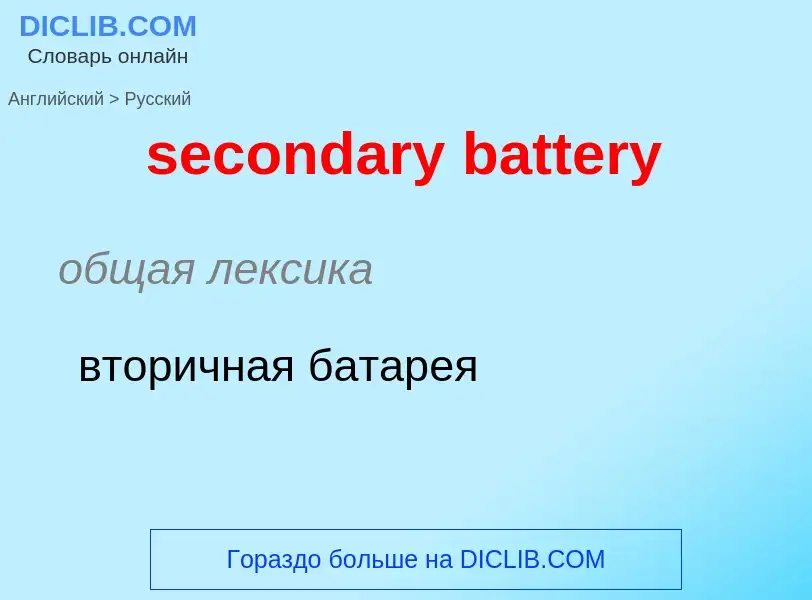Перевод и анализ слов искусственным интеллектом ChatGPT
На этой странице Вы можете получить подробный анализ слова или словосочетания, произведенный с помощью лучшей на сегодняшний день технологии искусственного интеллекта:
- как употребляется слово
- частота употребления
- используется оно чаще в устной или письменной речи
- варианты перевода слова
- примеры употребления (несколько фраз с переводом)
- этимология
secondary battery - перевод на русский
общая лексика
вторичная батарея
Определение
Википедия

A rechargeable battery, storage battery, or secondary cell (formally a type of energy accumulator), is a type of electrical battery which can be charged, discharged into a load, and recharged many times, as opposed to a disposable or primary battery, which is supplied fully charged and discarded after use. It is composed of one or more electrochemical cells. The term "accumulator" is used as it accumulates and stores energy through a reversible electrochemical reaction. Rechargeable batteries are produced in many different shapes and sizes, ranging from button cells to megawatt systems connected to stabilize an electrical distribution network. Several different combinations of electrode materials and electrolytes are used, including lead–acid, zinc–air, nickel–cadmium (NiCd), nickel–metal hydride (NiMH), lithium-ion (Li-ion), lithium iron phosphate (LiFePO4), and lithium-ion polymer (Li-ion polymer).
Rechargeable batteries typically initially cost more than disposable batteries but have a much lower total cost of ownership and environmental impact, as they can be recharged inexpensively many times before they need replacing. Some rechargeable battery types are available in the same sizes and voltages as disposable types, and can be used interchangeably with them. Billions of dollars in research are being invested around the world for improving batteries and industry also focuses on building better batteries. Some characteristics of rechargeable battery are given below:
- In rechargeable batteries, energy is induced by applying an external source to the chemical substances.
- The chemical reaction that occurs in them is reversible.
- Internal resistance is comparatively low.
- They have a high self-discharge rate comparatively.
- They have a bulky and complex design.
- They have high resell value.


![[[BYD e6]] taxi. Recharging in 15 Minutes to 80 percent [[BYD e6]] taxi. Recharging in 15 Minutes to 80 percent](https://commons.wikimedia.org/wiki/Special:FilePath/2014 BYD E6.jpg?width=200)



![[[Lithium ion battery]] monitoring electronics (over- and discharge protection) [[Lithium ion battery]] monitoring electronics (over- and discharge protection)](https://commons.wikimedia.org/wiki/Special:FilePath/Lithium Ionen Akku Überwachungselektronik.jpg?width=200)
![lithium polymer]] [[mobile phone]] battery lithium polymer]] [[mobile phone]] battery](https://commons.wikimedia.org/wiki/Special:FilePath/Nokia Battery Hologram.jpg?width=200)
![A [[solar-powered charger]] for rechargeable AA batteries A [[solar-powered charger]] for rechargeable AA batteries](https://commons.wikimedia.org/wiki/Special:FilePath/Solar AA charger 01 Pengo.jpg?width=200)
![USS ''Massachusetts'']] 5-inch (127 mm) secondary gun battery (note the somewhat comical elevation angles demonstrated by the center and background turrets). USS ''Massachusetts'']] 5-inch (127 mm) secondary gun battery (note the somewhat comical elevation angles demonstrated by the center and background turrets).](https://commons.wikimedia.org/wiki/Special:FilePath/5 inch turrets aboard USS Massachusetts (BB-59).jpg?width=200)
![SMS ''Radetzky'']] SMS ''Radetzky'']]](https://commons.wikimedia.org/wiki/Special:FilePath/Austrianbattleship Radetzky.jpg?width=200)
